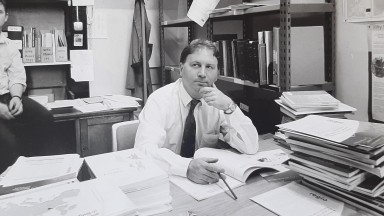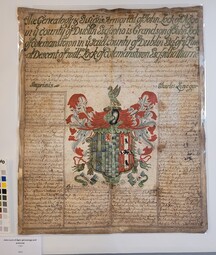1) How long have you worked for the NLI?
I’ve worked at the library for 43 years. I joined in September 1979, when I was just 17 years old. My first role was as a Library Attendant, which I worked at for a number of years, then as a Library Assistant, and then a Senior Library Assistant. I was in charge of staff and rosters, which progressed into working as the Health and Safety Officer in our Estates Department.
I was always interested in health and safety, and it’s fascinating to see how this smaller aspect of my earlier roles came into its own as time went on. We take it for granted now, but there wasn’t as much legislation for health and safety when I started out. As my career progressed, I was focussed on raising the profile of health and safety. Over the years, you evolve, and policies develop.
When COVID-19 hit, the NLI already had a strong foundation and emphasis on health and safety, which helped us to prepare as best we could in unprecedented times. We all worked together to help keep the public and staff safe. It was hard work, but also an interesting and unique challenge – that being said, I wouldn’t want to repeat it!
In future, people will watch footage from 2020 on Reeling in the Years, and children will be asking, “why are people wearing masks?” and “why are the streets empty?”.
“When people ask if I’m 40 years in the one job, I say I may be 40 years in the one job, but I did not do the one job for 40 years.” – John O'Sullivan
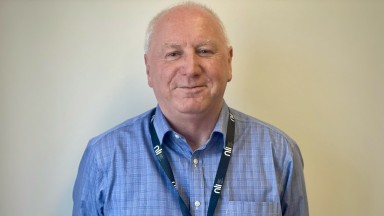
John O'Sullivan, June 2023
2) Tell us about your first day/earliest memory?
Let me wipe away some cobwebs there!
First impressions? I found the NLI building daunting, and was put straight to work. On my first day, I went to the Department of Education on Marlborough St, where you signed the Official Secrets Act (the NLI has been under several Departments since then.)
When I went for the job interview, age 17, I returned home to my mother. “How do you think you did?”, she asked. I said, “It went well, but I wouldn’t like to work there – it smells of old musky books!” Of course over time, I grew to like that smell.
When I was appointed, I was reading the conditions of the job, which included being on duty on Christmas Day, on nights, etc. My mother, who was a wise woman, said “Go in, and try it for a week.”… And I’ve been trying it for a week at a time ever since!
My sister later pointed out that my grand-uncle was the first librarian in Kenmare Public Library, so it’s in the blood, to carry on the tradition.
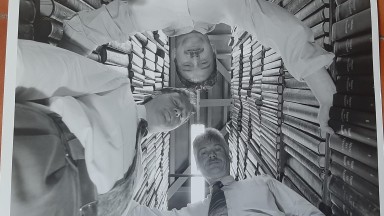
John O'Sullivan, Jim O’Shea and Kieran Carey, Top of the House in the West Wing, where Official Publications were stored, circa 1997-98. The photographer got on the floor and took the photo looking upwards to give a sense of height.
3) What's your proudest moment/achievement in your career at the NLI?
I think my greatest achievement is my own development, and the way I changed with the times, and watched the library grow. Particularly in the way people access information, I think the NLI has done well there and embraced the challenge.
One thing I’m very proud of, is a number of years ago, Martin McAleese [husband of former Irish President Mary McAleese] was doing research into the Magdalene Laundries.
He was trying to get records of people who had been in them, and I was asked to help out. Records had been destroyed, or not kept, so working behind the scenes, I did research on the Register of Electors. We had all the addresses where the laundries were located, and because the women were brought out to vote during general elections, we managed to gather quite a number of names from those records.
4) Have you changed roles, and if so, what was your favourite position?
I’ve enjoyed each role that I have had in the Library, but as you grow and change, I liked taking on more responsibility. As a Library Assistant, I was more involved with the Reading Room which I enjoyed very much helping the readers with their research and queries, and as a Health and Safety Officer, my role was working more behind the scenes ensuring the safety of all in our buildings.
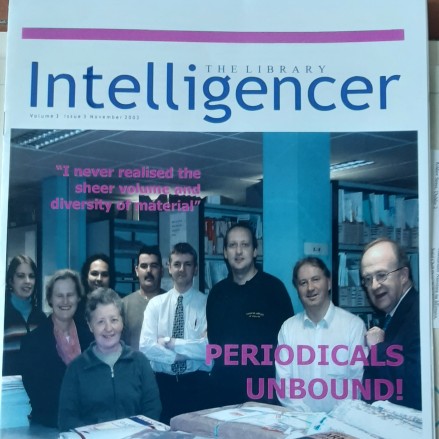
Intelligencer magazine, 2003. Above, L-R: Mary Broderick, Colette O'Daly, Hyder Abbas, Inez Fletcher, Noel Brady, James Harte, Joe McCarthy, John O'Sullivan and Dónall Ó Luanaigh
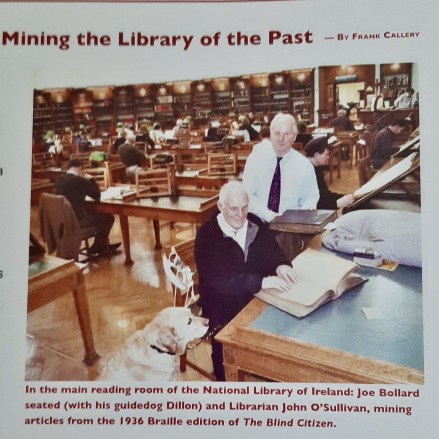
The NLI had one of the oldest copies of 'The Blind Citizen', a rare braille publication. Joe Bollard came to read it and translate it, as he was one of the few who could read this older version of braille.
5) Biggest change you've seen at the NLI since joining?
How we access information. And the improvements with the structure of the NLI, to give greater access to all.
The library was always under various Departments since I started, but since then the NLI has gone semi-state, and the library has been able to make more of its own decisions and changes. The biggest advance in the library has been technology.
Access to genealogy records stands out as an example – you used to have to physically go to the archives, costing you money and time. And you often didn’t have much success, and while it was great looking at the original census and documents, it was a slow process! I’m fascinated that nowadays, you can access these records from home, and from anywhere in the world, and it’s totally free!
My wife’s father was from Donegal, and she didn’t know much about him. So about 20 years ago, I looked into it, and found he was born outside Ballyshannon. We found the house where he was from, and my wife was quite emotional. I can imagine someone coming from America or abroad, how they must feel discovering their roots.
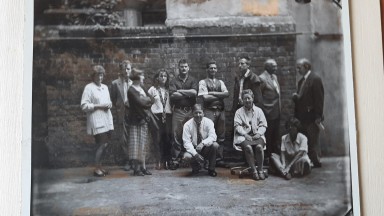
NLI staff in the courtyard outside the old photographic studio in the West Wing, circa 1997-98. Present-day staff include: John O'Sullivan, Matthew Cains and Grainne MacLochlainn.
6) In 40 years-time, how do you think the NLI will evolve?
The biggest challenge is to capture what’s already out there – in the sense, there’s so much online, and the way people communicate – and how we capture that, and store for future generations.
We take so many photographs now and store them on memory cards and in years to come, how will we will know who was that, what was that, etc., in the photographs?
How people communicate, in particular, is also going to change.
How do we make ourselves relevant to all aspects of Irish society? We are doing our best, but we need to engage further, and reach out to more diverse communities. The NLI has done a lot of good work on this already.
One of the best changes I’ve seen at the NLI is improved access for all. There’s been a lot of excellent work done by our Estates team, Brian, Mark and Elaine, in relation to this. Improvements such as automatic doors, ramp access, gender neutral toilets, all these changes are a great step in the right direction.
The other challenge, I believe, is what role the physical library building will become over time – will it at some stage exist somewhere else? Think of all the storage required to maintain both physical and digital records... Imagine if digital records had existed 100 years ago, like when the Customs House went on fire, and what if all those records hadn’t been destroyed?
When I started in the library, it was viewed as a library of last resort – if you could get the information you were looking for from your local library, it was the preferred route. Whereas now, we are viewed as a library for all, which I think is very important.
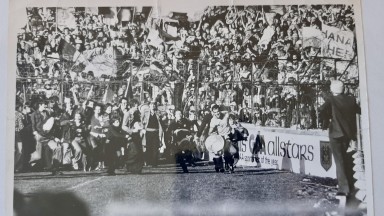
All Ireland Final in September 1977 between Dublin and Armagh. The papers used to have a "spot the ball" competition. How many can spot John O'Sullivan in the photo?
